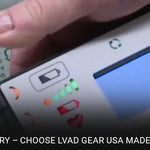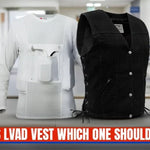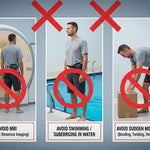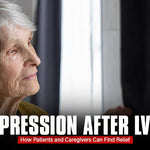
Learning how to travel with your LVAD
Life after a Left Ventricular Device can be a bit different. But it is not true that your life becomes restricted. You can still enjoy your life and live independently. You just need some modifications and preparation. Most people are concerned about travelling after LVAD and think that you cannot go outside or plan a trip with your family. It is not true. You may have to prepare and consult with your doctor before that, but it is not impossible to travel.
After having an LVAD, you may have learned about the beginner’s guide to LVAD. But one of the other important things after handling an LVAD effectively, you need to learn is how you travel safely with your LVAD without compromising on the device protection.
After an LVAD, it is necessary for you to prepare in advance when you are travelling, and you must know the ways to keep yourself free during your trip. Here is a complete guide for you to travel with an LVAD, while keeping your quality of life good.
A step-by-step guide to travel with your LVAD:
-
Consult with your healthcare professional:
Before making travel plans, you need to consult with your doctor and ask him if it will be safe to travel. You should discuss your travel plan with your doctor so that he can be in contact with you at all times.
-
Find a specialist at your destination:
For an emergency, you should find an LVAD center at your destination in advance in order to keep yourself safe by having the medical facility and support.
-
Plan your activity level and discuss it with your healthcare professional:
Your doctor will recommend a physical activity level according to your present health, so that you can enjoy the whole trip without fatigue.
-
Create and make your travel plan in case of longer routes:
You should also plan and make an itinerary for your travel so that you can execute an emergency plan in the time of need.
-
Keep your prescribed medication document:
One of the most important things is to keep your medical documents with you at all times, especially your prescription. In case your trip extended for some reason, you can have all the necessary medications and LVAD equipment details to buy them from anywhere.
-
Keep your TSA Notification Card:
TSA is the Transportation Security Administration, which involves screening for security purposes while traveling. You must have a TSA notification card with you so that you do not have to go through metal detectors that can interfere with the LVAD pump functioning.
-
Pack your Luggage in a rigid bag:
Apart from the regular wear, you need to pack batteries and LVAD equipment in a rigid bag. Add an additional layer of foam to provide extra protection. You must pack an extra pair of batteries in case of an emergency.
-
Keep LVAD-specific Clothing and Accessories:
To efficiently keep your LVAD with you all the time and accommodate the device safely, you need an LVAD gear or accessories, including an LVAD vest HeartMate 3, active pack, and LVAD bags. The LVAD gear not only accommodates your device perfectly but also lowers your frustration and pain.
How to Pack for Different Travel Modes?
During travelling with your LVAD, you need to pack according to your travel mode. Here are the additional tips for you to travel safely according to your travel modes:
Travelling by Air:
First of all, it is completely safe to travel by air. It is a myth that patients with LVADs should not travel by air because altitude and air pressure can interfere with the LVAD pump. As discussed earlier, you should not go through an airport metal detector. Ask the security officer to check manually without using any machine.
Move more often and perform ankle pumping movements to allow circulation. Make a handbag for yourself to keep batteries, device equipment, medications, and dressing change supplies. It is important, especially for the longer routes.
Traveling by your Car:
You are generally able to drive after 7 to 9 weeks of LVAD surgery, but the time can vary according to your doctor’s recommendations. Initially, you should drive shortly and always keep your backup and a fully charged mobile with you. Do not wear tight seatbelts during travel, as they can press on your driveline exit site. Always inform your friends or a family member beforehand in case they can help you on the road.
Travelling by Cruise:
Gather knowledge about the cruise company and inform them about your medical condition in advance. Cruise companies often have a medical facility and are trained to provide emergency care. Inform them in advance to make them fully prepared.
Make your travel checklist:
It is a very effective technique to make a checklist, as there will be fewer chances for you to forget the important things. Here is a checklist of the most important items to carry, though additional supplies may be needed based on individual needs and travel plans:
-
LVAD controller
-
Extra fully charged batteries with an extra set
-
Battery charger and power cords
-
Power base unit or mobile power unit
-
Backup controller
-
Power adapter
-
Medical alert ID
-
LVAD travel letter from your healthcare provider
-
Emergency contact list
-
List of medications with doses and schedule
-
All prescribed medications
-
Dressing change supplies
-
Waterproof driveline covers
-
Dressing changing kit
-
HeartMate LVAD shirt
-
LVAD bag and sleeping belt
-
Printed LVAD documentation for airport security
-
Details of LVAD centers near your destination
The Importance of the Right Gear for LVAD Patients while Travelling:
LVAD gear or LVAD apparel is a must-have when you are travelling. It not only provides safety to your LVAD equipment, but also allows you to move freely without any restriction. It is necessary for you to enjoy your trip and live a good quality of life, like everyone around you.
Invest in quality products like those provided by LVADGear. They offer LVAD apparel and accessories with a premium experience and provide both safety and freedom of mind.
Additional things you may need while traveling:
You may need additional things to carry with you to make your trip more comfortable and safer. Here are some of the suggestions:
-
Pack a dressing changing kit with you and learn how to change your own LVAD dressing.
-
Extra LVAD equipment and batteries
-
LVAD clothing and accessories
-
Pack a week of extra medications
-
Emergency contact information
-
LVAD center details at your destination
What should you do in an emergency situation as a caregiver?
In case of an emergency while travelling, you need to assess the situation first before responding. Here are some of the things you should do if you see a patient with an LVAD in a deteriorated state:
-
Look at the controller’s alarm, and see what it says
-
Read the medication list or LVAD letter of the patient
-
Call your emergency services immediately
-
Contact the nearest hospital with an LVAD facility
-
Do not perform CPR or chest compression on the patient with an LVAD
-
Check if there is any disconnection of cables and the controller wire
LVAD restrictions while travelling:
When traveling with an LVAD, it is important to be aware of certain restrictions.
-
Avoid high-altitude destinations, as reduced oxygen levels can affect your device and overall health.
-
Be cautious in crowded areas where the risk of injury is higher.
-
Additionally, always check with airlines and transportation services about their policies regarding traveling with medical equipment.
-
It is a good idea to have a plan for equipment maintenance and access to medical facilities at your destination in case of emergencies.
How do I travel with my LVAD?
Packing up your LVAD equipment and dressing change material, and meds is crucial. For equipment, I used a 26″ suitcase on wheels to pack my night machine, battery charger, extra batteries, then wrapped them all in 1.5” foam. I packed them tightly and also added some dressing change supplies. This was my Traveling LVAD Bag. I also carried a heavy extension cord and a plug that went from 3 to 2 prongs in case the hotel did not have grounded outlets. All of the fair-to-good hotels do, and some even have handicap rooms close to the front. They don’t advertise it, or usually charge more, so you have to ask. Being able to travel alone is a freedom that can’t be explained, but it sure is beautiful.
I also use a checklist for packing that covers all machines, dressing change materials, and all medicines, including the “as-needed meds”. There is nothing worse than that feeling you forgot something – the checklist eliminates that.
Final Notes:
Traveling with an LVAD is possible and can be enjoyable with the right planning and preparation. By consulting your doctor, knowing where to find medical help, keeping important documents in hand, and packing your LVAD equipment safely, you can have a smooth trip. Whether you are flying, driving, or going on a cruise, just remember to take care of yourself and follow the guidelines. Having an LVAD shouldn’t hold you back from experiencing life to the fullest. With the right approach, you can travel safely and confidently.
Prev post

LVAD Gear History – Choose LVAD Gear USA Made From the Heart
Updated on 21 May 2019
Next post

Learning how to do your own LVAD Dressing Changes
Updated on 10 January 2018








